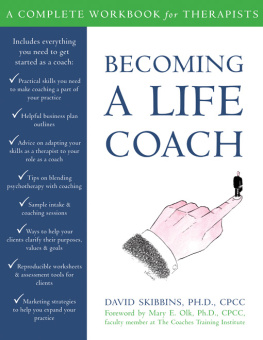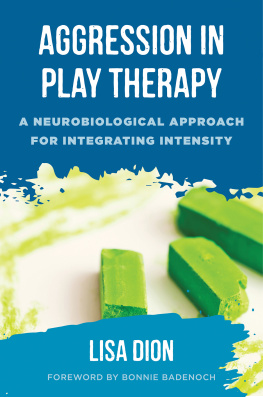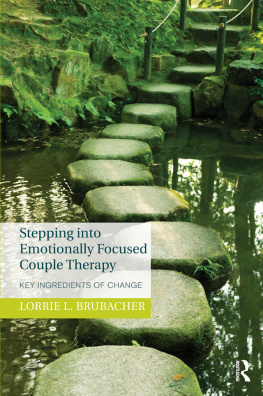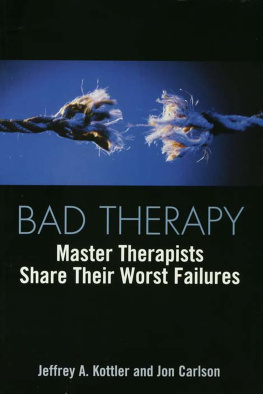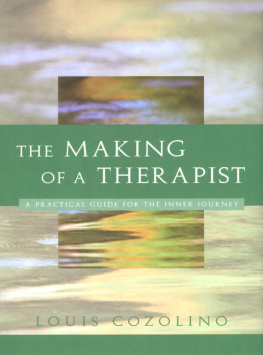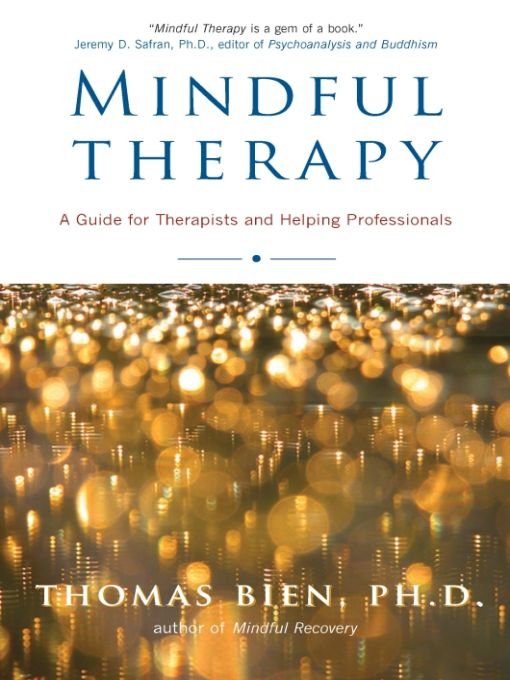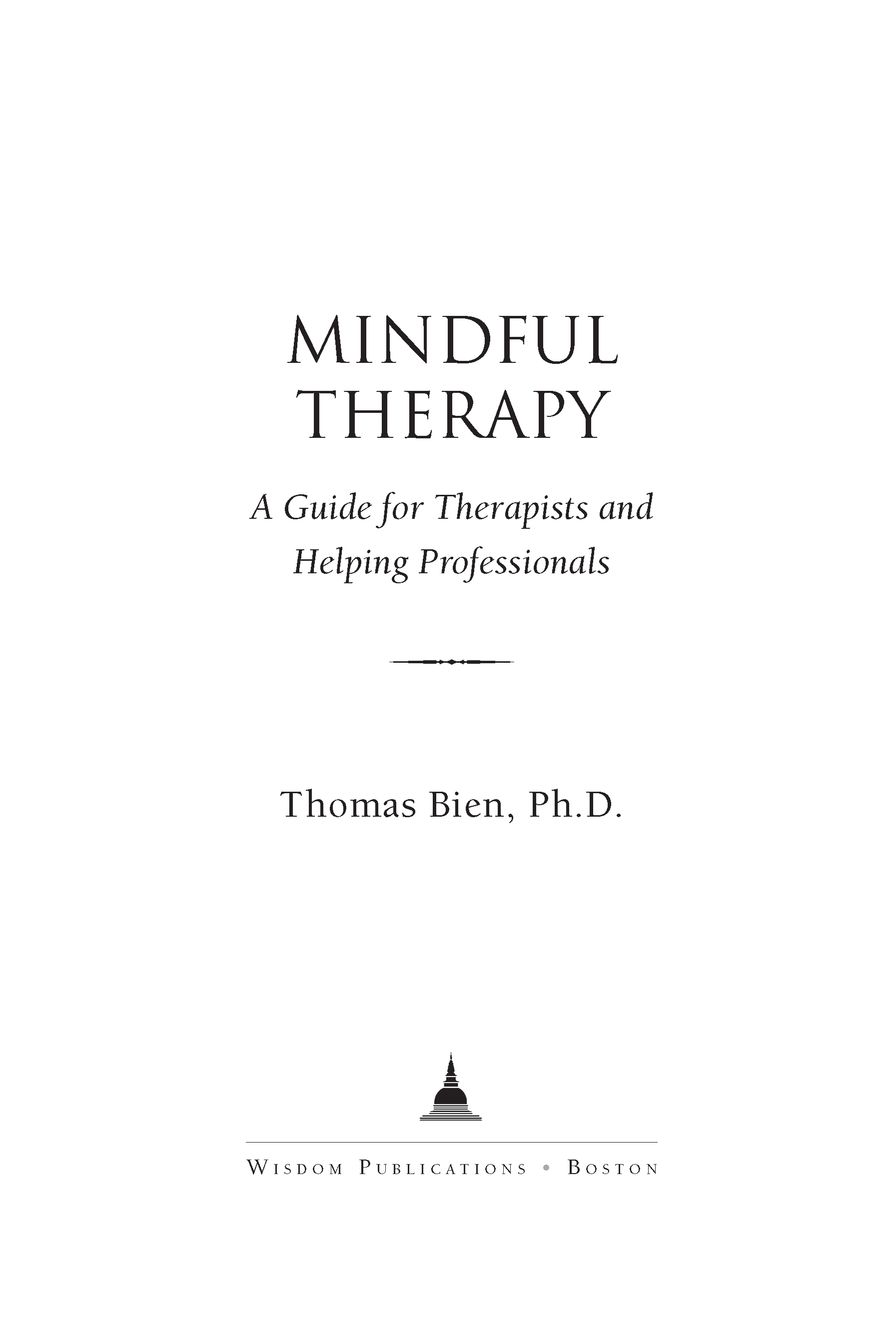Table of Contents
MINDFUL THERAPY
This is the voice of a wise and sincere practitioner of both emotional healing-mindfulness and psychotherapy. Tom Bien reminds helping professionals to fully embody mindfulness in their livesto be presentif they wish to share it with others. He explains the core ideas of Buddhist psychology in language that is likely to make sense to beginners and seasoned practitioners alike, and he provides a wealth of insights and techniques to make the teachings more accessible to clients. This book is a rich and timely contribution to our understanding of how to integrate the ancient practice of mindfulness into modern-day psychotherapy.Christopher K. Germer, PhD, Harvard Medical School, and co-editor, Mindfulness and Psychotherapy
Using theoretical groundwork, personal experience, case studies and practice exercises, Mindful Therapy offers ways to bring the teachings of Buddhism into a psychotherapeutic practice, and provides a thorough explanation of the benefits of doing so.Albuquerque Tribune
Dr. Bien skillfully weaves through his book the essentials of Buddhism, of which he has an excellent understanding. [] Replete with exercises for the therapist outside of the consulting room, as well as practical suggestions for the therapeutic interaction itself, the book covers a wide territory. [...] Mindful Therapy has a kinship with Carl Rogers and On Becoming a Person. The general reader will easily appreciate from this book the salutary effects of the practice of mindfulness, and the interconnection of mindfulness and emotional well-being.
Wildmind Newsletter
Buddha was not a philosopher trying to explain the universe.
He was a spiritual guide who wanted to help us put
an end to our suffering.
THICH NHAT HANH
To Beverly
PREFACE
WHILE THIS BOOK seeks to outline an overall approach to therapy, it cannot of course be a complete text in this regard. It cannot tell you everything you need to know about therapy. And if I cannot claim this is a complete manual for doing psychotherapy, I also cannot claim the ideas herein are in any sense definitive, or that they amount to more than one therapists view of how Buddhist ideas can be worked with in clinical practice. And while both new therapists and experienced therapists might read this book profitably, its purpose is as much inspirational as technical.
Although Mindful Therapy focuses on psychotherapy, other professionals who want to learn to listen more deeply to the people they work with will also find content of interest here, including physicians, attorneys, teachers, and so on.
A word about words:
Therapy and psychotherapy. I use these terms in the broadest sense, not differentiating these from counseling, pastoral counseling, analysis, and so on.
Patient or client. Both of these terms present problems. Both have their limitations. On the one hand, client always sounded to me like someone that we are trying to sell to. A client is someone the insurance agent, the stockbroker, or the banker deals with. It doesnt strike quite the right note. On the other hand, patient seems to emphasize the dominance and superiority of the therapist too much. Patient implies a far too passive role for what the person in therapy or counseling must do. In everyday life, I use these terms interchangeably. But for consistencys sake, I have used patient throughout the book for several reasons.
First, using the word patient is to my mind in keeping with the Buddhist principle of acknowledging the truth. In this era of political correctness, there is a tendency to use terms for things which disguise what they actually are. The word patient seems in some ways more honest, since it denotes an important part of the reality of the therapeutic relationship: patients come to us because they are suffering, and because they hope we can help.
When we use the word client, we may do so with the admirable goal of reminding ourselves that all beings are equal, that none should hide behind an assumed professional superiority. In practice, however, I think this term does little to help with this. The end result of avoiding the use of the word patient may actually be to devalue the role of the therapist rather than to elevate the person on the other side. And these days, I think therapists could use some help in remembering to value what they do, and in teaching the world to do so.
Whichever term is used, however, the practitioner of mindful therapy is hardly someone that will dominate, manipulate, or control the people she works with. Calling someone a patient will not present any difficulty in the atmosphere of mindful therapy, which by its nature communicates a deep respect. Like the bodhisattva named Never Disparaging, we should remember that everyone is a future buddha.
He and she. I have alternated use of masculine and feminine forms of the third person singular pronouns in an approximately equal fashion to indicate a person in general. As with the use of patient and client, there are other options worth considering. But overall, I find this the least awkward way to avoid gender-biased language.
Finally, I wish to address the issue of the identities of patients discussed herein. Case histories in this book are generally based on composites of multiple individuals to crystallize important points that might take much longer to explicate through presentation of single cases. They are all based on reality, however, and are not purely fictional.
Even when a case history is based primarily on a single person, identifying information is altered to disguise the identity of patients. In other words, if it sounds just like you, it isnt.
So many beings go into the making of a book that an acknowledgment can easily sound like one of those endless Oscar acceptance speeches. But let me thank all whose love, support, and friendship provide the needed encouragement to write a book. Especially important in this regard are my wife Beverly, my son Joshua, and my dear friends Joe Boroughs and Steve Barrilleaux. I would like to thank my many spiritual teachers and psychological teachers, among the former, Thich Nhat Hanh, Rollo Michael, and Jim Harris, not to mention Siddhartha Gautama and Jesus of Nazareth; among the latter, Bill Miller and Chuck Elliott. Bob Weber has provided helpful guidance and feedback along the way. Scott Love, as always, deserves many thanks for keeping my computer running. I often wonder what I would do without him.
At Wisdom Publications, I would like to thank my editor Josh Bartok for seeing the value of this project and helping to bring it into being. His insight has helped this be the best book it could be. I am also grateful to production editor Tony Lulek and promotions and marketing coordinator Rod Meade Sperry.
Last but by no means least I want to thank the many patients I have worked with over the years. Some of these have been difficult teachersthe kind of Zen master who beats you with a stick when you get it wrong, or even, in some cases, when you get it right! Many more have appreciated my efforts to offer presence, support, and guidance. Every single one of them has been my teacher.


